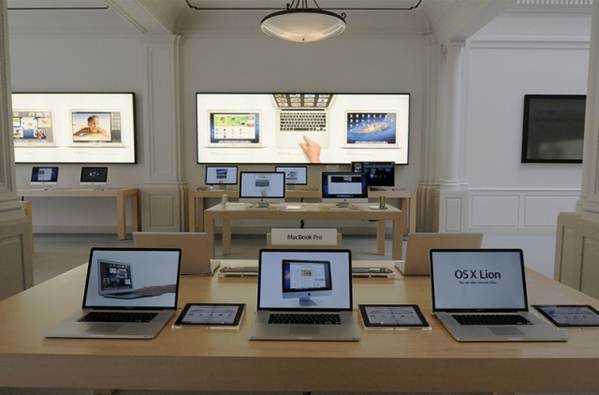Still, unless it was a cryptic joke, the
remark is at least smoke, if not fire. Some analysts think Apple could get
burned. Quoted by Forbes in May 2012, Pacific Crest’s Andy Hargreaves reckoned:
‘Apple should rethink building a television set if it doesn’t have anything
special to differentiate its content’. And that something special could prove
very tricky to acquire. ‘We do not except US broadcast or cable networks to
provide Apple [with] content if it risks cannibalizing existing revenue, which
makes a unique Apple service [delivered through] an Apple television unlikely’.

Apple,
with the ties to the entertainment industry forced personally by Steve Jobs, is
uniquely placed to facilitate change in television
Hargreaves has a point: consider, for
example, that US cable TV service HBO has declined to make its smash hit Game
of Thrones available in any standalone format, forcing casual viewers to pay
for a full cable subscription just to get one show or wait months for a digital
release. The policy has helped to make the latest series the most pirated this
year, according to Forbes, as well as royally annoying a large chunk of its
potential audience; but evidently HBO believes the hard cash is worth it.
Just as off-putting are the physical
challenges of stocking an HDTV alongside iPads and iPhones. Apple Stores are
among the most profitable retail outlets in the world, but a typical 46in
television would be ‘a terrible use of retail space’, argues Hargreaves. His
back-of-an envelope numbers aren’t pretty: a smart TV would generate less than
a fiftieth of the iPad’s profit per cubic foot of shop floor, and less than
0.5% of what apple makes from iPhones.

Apple
Stores are among the most profitable retail outlets in the world, but a typical
46in television would be ‘a terrible use of retail space’, argues Hargreaves.
In fairness, Apple also retails 27in iMacs,
but those are still much smaller and more expensive than a living-room screen –
and the users who buys one is likely to be back through the door two or three
years later for another. Software and its demands move on; consumer video
formats, not so much.
If it’s lonely at the top, Cupertino must
be a friendless place these days. With its tech industry competitors now far
out of sight beneath the clouds, Apple has only its mountain of cash to keep
economic downturn hasn’t yet caused any landslides. That doesn’t mean the
current level of growth is sustainable. At the time of writing, stock in AAPL
has slipped from over $600 back to the $540s. It’s a short-term blip in the
calendar gap between product release, but still a warning that the only way is
not up. Horace Dediu’s comments on demand notwithstanding, the question remains
whether a company can just grow and grow and never stop. A recent New York
Times story is not sanguine about future prospects. ‘If Apple’s share price
grew even 20% a year for the next decade, which is far below its current
blistering pace, its $500bn market capitalization would be more than $3
trillion by 2011. That is bigger than the 2011 gross domestic product of France
or Brazil.
‘Put another way, to increase its revenue
by 20%, Apple has to generate additional sales of more than $9bn in its next
fourth quarter. A company with $1bn in sales has to come up with just another
$200m’.

Since
Cook’s appointment, Apple has taken action to assuage Wall Street’s inevitable
concerns.
The NY Times goes on to quote Robert Cihra,
who covers Apple at Evercore Partners and says the ‘law of large numbers’ as
applied to Apple has been a concern for some time. ‘Over the past couple of
years, they have actually accelerated revenue growth. I don’t know that can
continue indefinitely. If financials you extrapolate far enough out into the
future, to sustain that growth, Apple would have to sell an iPhone to every
man, woman, child, animal and rock on the planet’.
Even by Jobsian standards, that sounds
hubristic. But then any extrapolation will break down at some point. What
exactly is this law of large numbers that has everyone worried? It’s much
misunderstood, complains blogger Dr Drang (leancrew.com). ‘The law does not
state that a variable will revert to a mean over a large sample of results. It
says nothing about individual measurements; it’s all about averages. And it
certainly doesn’t suggest anything about the future growth of large companies’.
That’s not to deny, of course, that
maintaining growth is more difficult for bigger companies. It’s a cause of
widespread surprise, as well as admiration, that a 36-year-old firm can be,
according to Forbes, the second fastest-growing in its sector. And since Cook’s
appointment, Apple has taken action to assuage Wall Street’s inevitable
concerns.
Jobs was content to hold on to all the
crash the company had no immediate reason to spend, as is fairly common for
tech outfits, referring vaguely, if asked, to possible opportunities around the
corner. Cook has changed tack by initiating the first dividend payment in 17
years – a move that will please shareholders in that it gives them an immediate
return, but is conventionally seen as heralding the end of a company’s growth
phase, offering cash today in place of stock price movement tomorrow.
The quarterly dividend of $2.65 a share,
starting with the fourth quarter of 2012 (which begins in July), is ‘equivalent
to a dividend yield of 1.8%’, calculates the FT, ‘below the level paid by tech
concerns such as Microsoft but higher than the 1.5% paid by IBM. [Apple’s]
estimated $10bn dividend will be second only to AT&T in terms of absolute
payout among US companies’.